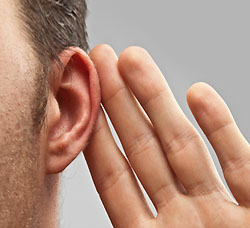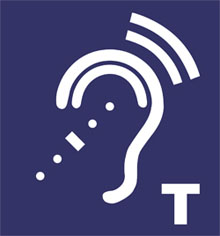It’s always interesting when old technology becomes new again. We see it daily in our lives, but I’m referring to a specific type of old tech: hearing loops.
The technology, which is correctly known by the name of inductive loops, has been in existence for decades. Based on Faraday’s law of induction, a magnetic field is created and individuals that have a Telecoil (t-coil) equipped hearing aid, can receive audio signals directly in their hearing aid.
A “loop” is a relatively low-tech solution. In simple terms an area is surrounded “looped” with a piece of copper wire. An amplifier drives signal down that wire creating a magnetic field inside the “loop.” To receive the magnetic signal, a person inside of the field simply has to switch their hearing aid to the “T” (t-coil) position.
With the current ADA (American Disabilities Act) requirements and an aging population, providing a loop-based hearing assistance system can be beneficial not only for compliance, but also for the convenience and benefit of parishioners.
With 36 million of Americans reporting hearing loss and over 8 million already outfitted with hearing aids, the need for hearing loops continues to grow. And, there has been no stronger advocate than David G. Myers, PhD, professor and social psychologist at Hope College in Holland, MI.
Several years ago, while visiting Europe and attending a service at an old cathedral, Myers noticed a “Hearing Loop Installed” sign on the wall, and it triggered a memory. Specifically, he recalled the advice of the audiologist from whom he had purchased his hearing aid. Seeing the sign, he flipped a switch on his hearing aid, and suddenly, he was he tapping directly into the house audio.
From that moment, Myers has been, and continues to be, a huge supporter of the technology. He is the creator of hearingloop.org, a website that provides education and information on hearing loops.
“I activate my T-Coils and instantly the speaker’s voice comes to me not from some distant loudspeaker but seemingly from the center of my head,” says Myers. “My hearing aids now serve me as customized wireless loudspeakers.”
There can, of course, be challenges when installing a loop system. The most obvious being how to route the cable in an existing space, although this usually isn’t an insurmountable problem.
“In all of the existing buildings in which I have designed and installed loops, including very old churches, airport terminals and sporting venues, like the Michigan State Breslin Center, I’ve always found somewhere to hide the wire for the loop system,” says Tim Vander Meer of Hearing Loop Systems, which, as the name implies, is a company that specializes in designing and implementing this technology.
A loop can cause a high pitched noise through some instruments pickups such as guitar, piano, strings. Generally speaking, this usually happens on older pickups or installations where there is not a solid ground present. Spillover into adjacent rooms can also be an issue; this also can be overcome by using a properly designed phased array system.
The advantage of a loop is that there is no need for portable receivers and batteries, because the T-coil in the hearing aid requires no power. Additionally, the hygiene issue goes away as earphones do not need to be cleaned and shared.
There is also a cost/benefit savings compared to traditional RF and Infrared systems, as the only limit on users of loop systems is physically how many people can fit inside of a loop.
As you face what could be an increased demand for assisted listening systems for parishioners, loop systems are something to keep in mind.



















